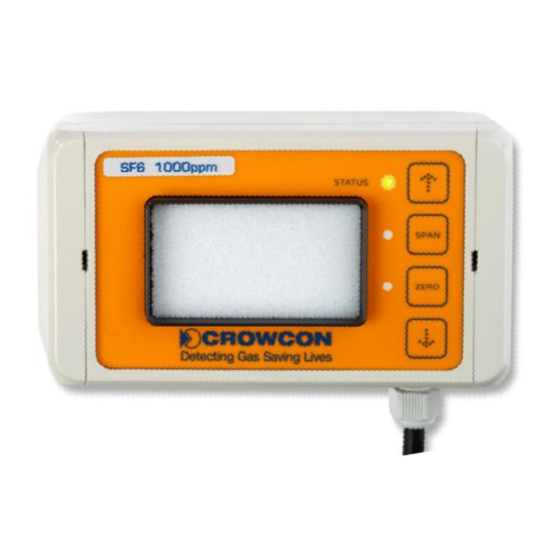Crowcon 40/40M Руководство по эксплуатации и техническому обслуживанию - Страница 5
Просмотреть онлайн или скачать pdf Руководство по эксплуатации и техническому обслуживанию для Детекторы газа Crowcon 40/40M. Crowcon 40/40M 20 страниц. Infra-red sf6 and refrigerant gas detector

The connection of the internal IR sensor module to the interface electronics is via a 4-pin
The connection of the internal IR sensor module to the interface electronics is via a 4
The connection of the internal IR sensor module to the interface electronics is via a 4
data cable (Fig. 4). The circuit board is screwed to the internal built
outside. The IR gas sensor is integrated into this
gas sensor is integrated into this casing to minimize the dead volume and to
protect it from any unwanted external effects.
protect it from any unwanted external effects.
Figure 4: 4-pin data
Caution: The IR sensor module
operated as a pair. Both components form a fixed unit and must not be separated!
. Both components form a fixed unit and must not be separated!
. Both components form a fixed unit and must not be separated!
2.2.
Installation
The installation of the transmitter is described
The installation of the transmitter is described as follows.
The F-Gas detector should be
Gas detector should be mounted where the gas to be detected is most likely to be
present. The gas must come into direct contact with the sensor in order to be detected.
The gas must come into direct contact with the sensor in order to be detected.
The gas must come into direct contact with the sensor in order to be detected.
Detectors are typically installed
ypically installed around compressors, pressurised storage vessels,
refrigerant cylinders, within storage rooms or
from valves, pipe flanges and joints, pipe/vessel
pipe flanges and joints, pipe/vessel filling or draining connections, etc.
The following points should be noted when locating gas detectors:
The following points should be noted when locating gas detectors:
• To detect heavier-than-air gases
• Detectors must be mounted as close as possible to potential leak sources.
Detectors must be mounted as close as possible to potential leak sources.
Detectors must be mounted as close as possible to potential leak sources.
• When locating detectors consider the possible damage caused by
• When locating detectors consider the possible damage caused by water: rain, flooding,
or exposure to jets from hoses or pressure washers.
• Consider ease of access for functional testing and servicing.
• Consider ease of access for functional testing and servicing.
• Consider how the escaping gas may behave due to natural or forced air currents.
• Consider how the escaping gas may behave due to natural or forced air currents.
• Consider how the escaping gas may behave due to natural or forced air currents.
• Consider the process conditions. For example
released from a process at
he circuit board is screwed to the internal built-in
pin data cable connecting the IR sensor to the interface PCB
module is tailored to the connected interface PCB
mounted where the gas to be detected is most likely to be
around compressors, pressurised storage vessels,
storage rooms or adjacent to pipelines. Gas leaks typically occur
air gases detectors should be mounted at low level.
detectors should be mounted at low level.
from hoses or pressure washers.
conditions. For example heavier than air
at elevated temperatures and/or pressures.
F-Gas Detector
Gas Detector Instructions
in casing from the
to minimize the dead volume and to
to the interface PCB
interface PCB and must only be
Gas leaks typically occur
draining connections, etc.
water: rain, flooding,
gases may rise if
